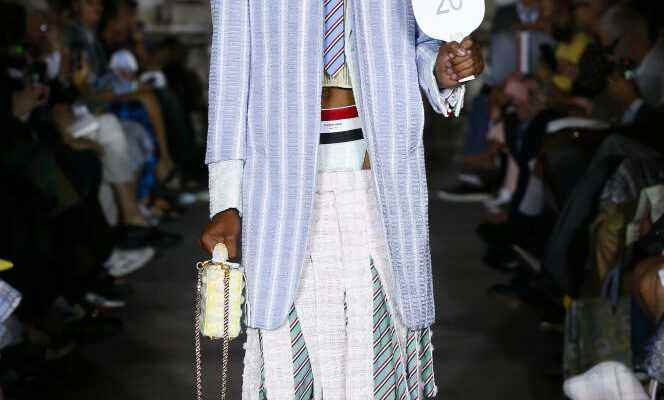From suits to moccasins, women’s fashion has not ceased, over the past ten years, to happily plunder men’s wardrobes. The reciprocal is beginning to take shape, as demonstrated by certain collections at Paris fashion week, from June 21 to 26. For example, a denim skirt and scarf attached to the earring have emerged at Marine Serre, tunics open on the thigh at Valette Studio, pointed boots at Y/Project…
The most spectacular version of this trend is signed by Thom Browne with his parody of the haute couture fashion show, a discipline usually reserved for women. It offers a succession of sailors dressed in tweed, an anchor on their face, but stripped of their virile captain’s poses. Cruising is fun! They don bikini tops, mini-dresses on hairy legs, pleated schoolgirl micro-skirts or low-waisted pants attached to jockstraps, the groin, hip and upper buttocks exposed.
“I imagine most people will see all of this as feminine. So I contrasted with strict costume, punk hairstyles, says Thom Browne. I wanted to push the preppy style [sportswear américain des années 50] in its entrenchments, in terms of proportions, up to an almost unrealistic point. » It is paradoxically a cliché of masculinity that closes the parade: a cowboy in a hat, bag in the shape of a cowboy boot and jockstrap with a shell (erect) in the crotch, to the laughter and applause of the audience.
Sailors also occupy a prominent place at Kenzo, in Nigo’s second collection. The Japanese designer presents men and women together, assuming fluidity, with boys in skirts or leggings, unisex suits, and pop culture for all. The designer was inspired by the 1980s, a fertile era for Japanese fashion, when internationally renowned designers who exported themselves to Paris fashion week coexisted with local brands focused on cartoon animal characters. Nigo reinterprets prints from the archives of founder Kenzo Takada through the wardrobe of rail workers and military repairmen of the 1930s and 40s in the United States. A joyful and colorful set, but which struggles to show modernity.
The right to delicacy
With his usual talent for color and print (stripes, polka dots, flowers, leopard, honeycombs, etc.), Dries Van Noten composes a heterogeneous collage of floating shirts, zipped pilot tank tops or embroidered bombers that he comes across with tops with thin straps or a black dress over silky trousers, borrowed from the women’s wardrobe and the Buffalo style of the 1980s. All in fluidity.
You have 40.99% of this article left to read. The following is for subscribers only.
